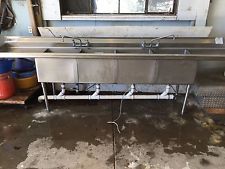From Eurosurveillance:
It is estimated that over 38,000 community cases of salmonellosis occur annually within the United Kingdom (UK) [1,2]. Salmonellosis often results from consumption of contaminated food or water [3], however, transmission via asymptomatic shedding by food handlers and exposure to contaminated environments where conditions are favourable for pathogen survival have also been implicated [3,4]. Here we report the findings of an investigation of an outbreak of salmonellosis where the environment was pivotal in continued transmission.
 On 7 March 2015, Public Health England (PHE) East Midlands was alerted by the clinical microbiology laboratory of a local hospital to 21 cases of Salmonella enterica serovar Typhimurium gastroenteritis, with onset in February 2015. Seven cases in this initial phase of the outbreak required hospitalisation. Following this notification we suspected there was a community outbreak of S. Typhimurium; investigations and attempts to control the outbreak followed.
On 7 March 2015, Public Health England (PHE) East Midlands was alerted by the clinical microbiology laboratory of a local hospital to 21 cases of Salmonella enterica serovar Typhimurium gastroenteritis, with onset in February 2015. Seven cases in this initial phase of the outbreak required hospitalisation. Following this notification we suspected there was a community outbreak of S. Typhimurium; investigations and attempts to control the outbreak followed.
Hypothesis-generating interviews at the outset of the investigation identified that several cases had eaten at the same restaurant during the incubation period for their illness. Descriptive epidemiological analyses including subsequent cases pointed to the restaurant being the likely source. This popular, purpose (newly) built restaurant had opened only 18 months before the outbreak. The restaurant offered a full table-service menu, self-service salad bar and hot self-service carvery buffet serving roasted meats (turkey, beef, gammon and pork at weekends) and vegetables and condiments. Despite interventions to control the initial outbreak, cases continued to emerge followed by a prolonged period of transmission until 2016. The evolution of the investigation into this community outbreak and subsequent control measures is described, with specific reference to the use of whole genome sequencing (WGS) to link isolates and the role of the drains in continued pathogen transmission.
Mapping and visual inspection of the drainage systems identified significant issues. Water filled traps (u-bends) designed to prevent foul air flow from the drainage system into the building had failed and smoke testing revealed some ineffective drain seals, potentially allowing contaminated bio-aerosol to be disseminated into the kitchen. One sink drain was not connected to any drainage system with waste water pooling under the floor. Other larger drains had failed after leaking waste-water washed away the supporting substrate forming a cavity under the kitchen area. It transpired at that point that drainage water had, on occasion, risen into the kitchen area, although this had not been previously reported. Substantial remedial works were undertaken, however, these were found to have failed on re-inspection and so these drains were later decommissioned.
 Biofilm [15] and flooded areas in underfloor cavities may have sustained this outbreak, after repeated environmental cleaning failed. Drainage problems in one area of the kitchen led to liquid from the drains seeping into the kitchen suggesting a contamination pathway. We found isolates matching the outbreak strain on kitchen cloths, swabs from kitchen sinks, and pot wash areas suggesting contact with sinks may have provided a second contamination pathway. We also identified ineffective drain water-traps potentially allowing the movement of contaminated bio-aerosols [13]. Smoke tests demonstrated the potential for dissemination of foul air into the kitchen.
Biofilm [15] and flooded areas in underfloor cavities may have sustained this outbreak, after repeated environmental cleaning failed. Drainage problems in one area of the kitchen led to liquid from the drains seeping into the kitchen suggesting a contamination pathway. We found isolates matching the outbreak strain on kitchen cloths, swabs from kitchen sinks, and pot wash areas suggesting contact with sinks may have provided a second contamination pathway. We also identified ineffective drain water-traps potentially allowing the movement of contaminated bio-aerosols [13]. Smoke tests demonstrated the potential for dissemination of foul air into the kitchen.
Investigation using whole genome sequencing of a prolonged restaurant outbreak of salmonella typhimurium linked to the building drainage system, England, February 2015 to March 2016
Eurosurveillance, John Mair-Jenkins, Roberta Borges-Stewart, Caroline Harbour, Judith Cox-Rogers, Tim Dallman, Philip Ashton, Robert Johnston, Deborah Modha, Philip Monk, Richard Puleston, https://doi.org/10.2807/1560-7917.ES.2017.22.49.17-00037
http://www.eurosurveillance.org/content/10.2807/1560-7917.ES.2017.22.49.17-00037
